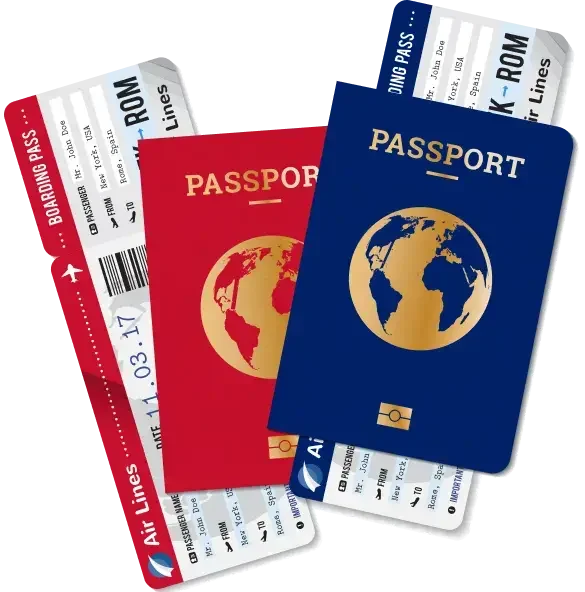Population
GDP (per capital)
Visa-Free Countries
GDP (purchasing power parity)
-
Immigrating to the U.S. Through Investment (2025)
- The United States continues to stand as a top choice for investors worldwide seeking not only financial opportunities but also the chance to establish permanent residency. In 2025, the landscape of investment-based immigration is evolving, notably with the introduction of the $5 million "Trump Gold Card" visa—a bold initiative designed to succeed the long-established EB-5 program. This article aims to guide prospective investors through the latest and most relevant pathways for securing U.S. residency via investment, highlighting key updates and considerations essential for making informed decisions in today’s dynamic environment.
- Main Industries
- Technology and Software Services
- Financial and Banking Services
- Healthcare and Pharmaceuticals
- Automotive and Aerospace Manufacturing
- Agriculture and Food Production
- Energy and Petroleum Industry

Washington D.C.
UTC−4 to −12, +10, +11
9,833,520 km2
USD
English

EB-5 Immigrant Investor Program
Established in 1990, the EB-5 Immigrant Investor Program has served as a prominent avenue for foreign nationals seeking permanent residency in the United States through business investment. By contributing capital to a qualifying U.S. enterprise, investors and their immediate families can obtain a Green Card, allowing them to live and work permanently in the country. The program is designed to stimulate economic growth and job creation across various regions.
EB-5 Investment Requirements
- Standard Investment: A minimum of $1.8 million must be invested in a new commercial enterprise that meets the program’s criteria. This higher threshold applies to most investments outside designated high-unemployment or rural areas.
- Targeted Employment Area (TEA): For investments made within a TEA—defined as locations with elevated unemployment rates or rural settings—the required amount is reduced to $900,000. This incentive encourages investment in regions that benefit most from economic development.
EB-5 Job Creation Requirement
A fundamental component of the EB-5 program is the creation or preservation of at least 10 full-time jobs for qualifying U.S. workers. These jobs must be direct or indirect results of the investment and are essential in demonstrating the economic benefit of the project.
EB-5 Recent Changes (2024 Updates)
- Increased Filing Fees: Beginning in April 2024, USCIS implemented a 200% increase in filing fees for Form I-526E, which is the initial petition for immigrant investors. This fee hike reflects efforts to cover program costs and improve processing infrastructure.
- Priority Date Retention: To alleviate some of the challenges faced by investors due to lengthy processing times, applicants are now allowed to retain their original priority date if they must refile their petition, providing continuity and reducing wait times in subsequent applications.
- Enhanced Compliance Measures: In response to previous concerns over program integrity, USCIS has introduced more rigorous oversight and background checks for regional centers and entities responsible for job creation. These measures aim to increase transparency and ensure that investments genuinely meet the EB-5 program’s requirements.
These updates illustrate the program’s evolving framework, balancing the need to attract foreign capital with maintaining strict standards to protect both investors and the U.S. economy.

E-2 Treaty Investor Visa
E-2 Treaty Investor Visa
The E-2 Treaty Investor Visa is a non-immigrant visa designed to enable nationals of countries that maintain a qualifying treaty with the United States to invest in and actively manage a U.S.-based business. Unlike immigrant visas, the E-2 does not directly grant permanent residency but allows investors and their immediate family members to live and work in the U.S. for extended periods, with the possibility of indefinite renewals.
Eligibility Criteria
- Treaty Country: Applicants must hold citizenship in a country that has a valid E-2 treaty agreement with the United States. This treaty framework is essential for eligibility.
- Investment: A substantial financial commitment must be made into a legitimate and operational U.S. enterprise. While there is no legally defined minimum investment amount, a typical guideline suggests investing at least $100,000 or more to demonstrate seriousness and viability.
- Business Control: The investor is required to maintain ownership of at least 50% of the business, ensuring active involvement in its direction and operations.
Investment Amount
Though no fixed minimum is stipulated by law, the amount invested must be sufficient to ensure the success of the business. Investments significantly below $100,000 often face greater scrutiny regarding their ability to sustain the enterprise.
Duration and Renewal
The visa is initially granted for periods ranging from three months to five years, depending on the applicant’s country of origin. Notably, the E-2 visa can be renewed indefinitely, provided the business continues to operate successfully and meets all regulatory requirements.
Recent Updates (2025)
Some treaty countries have recently introduced a residency requirement, stipulating that applicants must have been domiciled in their home country for at least three years prior to applying for the E-2 visa. This change aims to ensure stronger ties between applicants and their country of citizenship before moving to the U.S.
Overall, the E-2 visa remains an attractive option for entrepreneurs seeking flexibility and long-term business engagement in the United States without immediately pursuing permanent residency.
Trump Gold Card Visa (Proposed)
Trump Gold Card Visa (Proposed)
Introduced in June 2025, the Trump Gold Card Visa represents a groundbreaking proposal aimed at attracting affluent investors by offering a streamlined route to U.S. citizenship. This new initiative is designed to supersede existing investment-based immigration programs by providing a faster and more direct pathway for those willing to contribute significantly to the American economy.
Investment Requirement
Applicants are required to invest a minimum of $5 million into approved U.S. projects, underscoring the program’s focus on high-net-worth individuals capable of making substantial economic contributions.
Benefits
- Direct Citizenship Pathway: Unlike traditional programs that typically grant conditional residency before citizenship, the Gold Card Visa promises an accelerated and more straightforward path to obtaining full U.S. citizenship.
- Tax Incentives: Investors may benefit from generous tax advantages, including potential exclusion from U.S. taxes on foreign-sourced income, enhancing the program’s appeal to international wealth holders.
Controversies
- Real Estate Market Impact: Critics warn that such a high-investment requirement, particularly if focused on real estate, could exacerbate the already strained housing market in key urban centers, driving prices even higher and limiting affordability.
- Legal Challenges: There is ongoing debate regarding the legitimacy of implementing this program through executive action alone, without explicit authorization from Congress. These legal uncertainties could affect the program’s rollout and long-term viability.
While the Trump Gold Card Visa introduces an ambitious new option for investor immigration, it remains subject to scrutiny and potential legal hurdles that will shape its future in the evolving U.S. immigration landscape.
Comparison of Investment-Based Immigration Programs
| Program | Investment Amount | Job Creation Requirement | Path to Citizenship | Notes |
|---|---|---|---|---|
| EB-5 Immigrant Investor | $900,000 – $1.8 million | Yes — must create or preserve at least 10 full-time jobs | Yes — leads to permanent residency and citizenship | Established and widely recognized program with rigorous requirements |
| E-2 Treaty Investor Visa | Varies — typically $100,000 or more | No — job creation is not mandatory | No — non-immigrant visa with no direct path to citizenship | Flexible visa option for treaty nationals, renewable indefinitely |
| Trump Gold Card Visa (Proposed) | $5 million | No | Yes — expedited citizenship process | Newly proposed initiative with significant investment threshold and ongoing legal considerations |
This table highlights the key distinctions among the primary investment-based pathways currently available or proposed for obtaining U.S. residency or citizenship. While the EB-5 program remains a well-established route emphasizing job creation, the E-2 visa caters to entrepreneurs seeking flexibility without immediate citizenship prospects. The Trump Gold Card Visa, on the other hand, offers a novel, faster citizenship option for ultra-wealthy investors, though it awaits final legal and regulatory clarity. Understanding these differences is crucial for investors aiming to select the best option aligned with their goals and circumstances.
Conclusion
In summary, the United States offers several viable investment-based pathways for those seeking residency, each tailored to different levels of commitment and long-term goals. The longstanding EB-5 program continues to provide a structured route to permanent residency through substantial investment and job creation, while the E-2 visa presents a more flexible, non-immigrant option for entrepreneurs from treaty countries. Meanwhile, the newly proposed Trump Gold Card visa promises an expedited path to citizenship for high-net-worth individuals, though it remains under legal review. Given the complexities and frequent updates in immigration policies, prospective investors are strongly encouraged to seek guidance from qualified immigration professionals who can help navigate the nuances and select the most suitable program. As 2025 unfolds, it will be essential to stay informed on legislative developments and regulatory changes, particularly surrounding the Trump Gold Card initiative, to make well-informed decisions in this evolving landscape.
FAQ about Immigrating to the U.S. Through Investment
What is the minimum investment required for the EB-5 Immigrant Investor Program?
The standard minimum investment is $1.8 million, or $900,000 if investing in a Targeted Employment Area (TEA) with higher unemployment or rural status.
Does the E-2 Treaty Investor Visa lead directly to U.S. citizenship?
No, the E-2 visa is a non-immigrant visa that allows investors to live and work in the U.S. but does not provide a direct path to permanent residency or citizenship.
What distinguishes the proposed Trump Gold Card Visa from the EB-5 program?
The Trump Gold Card requires a higher investment of $5 million but offers an expedited and direct route to U.S. citizenship, unlike the EB-5 which grants conditional permanent residency first.
Should I consult an immigration expert before applying for investment-based visas?
Absolutely. Given the complexity and frequent policy changes, consulting with a qualified immigration attorney or specialist is essential to select the best program and ensure compliance with current regulations.
Looking for expert visa support?
PROGRAM MATCH
Compare the different programs in a nutshell and discover their features
PROGRAM COST
Check the cost estimates for each offered program
PROGRAM MAP
Explore the power of global mobility for every passport in the world
